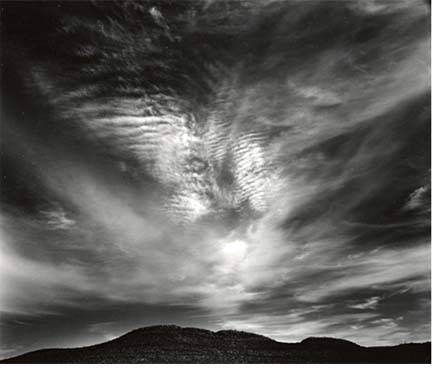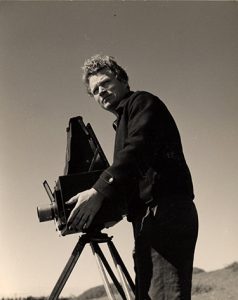
![]() The second son of photographer Edward Weston, Brett Weston was born in Los Angeles in 1911. When he was thirteen, his father removed him from school to spend a year in Mexico, where he learned to make photographs with a small Graflex camera. Influenced by his father, as well as by artists of the Mexican avant-garde, including Frida Kahlo, Diego Rivera, and Jose Clemente Orozco, from the start his work was informed by modernism.
The second son of photographer Edward Weston, Brett Weston was born in Los Angeles in 1911. When he was thirteen, his father removed him from school to spend a year in Mexico, where he learned to make photographs with a small Graflex camera. Influenced by his father, as well as by artists of the Mexican avant-garde, including Frida Kahlo, Diego Rivera, and Jose Clemente Orozco, from the start his work was informed by modernism.
Brett Weston’s early introduction to modern art influenced his photography for the remainder of his life. Form and composition were central aspects of his work, with emphasis on abstract design. Indeed, among the artists he most admired were painters and sculptors who explored abstract elements in their work, including Georgia O’Keeffe, the German Expressionists of the Blue Rider Group, and sculptor Constantin Brancusi.
In 1929 the Weston family moved to Carmel, California, where Edward Weston would maintain a home for the rest of his life. The following year, Brett Weston’s mother gave him an 8 x 10 view camera. Over the years, most of his work was done with either this type of camera or an 11 x 14 view camera, although toward the end of his life he used smaller medium format cameras that were easier to handle.
 Like his contemporary, Ansel Adams, Brett Weston photographed clouds in expansive Southwestern landscapes. Mountains and Clouds, New Mexico, a relatively early photograph, features a dramatic skyscape that rises above a distant mountain horizon. The high contrast between the light and dark clouds creates a nearly-abstract design that only becomes legible with the recognition of the mountains below. However, while Adams developed his zone system to retain detail in dark shadows and highlights, Weston frequently allowed dark areas to read as unified shapes. As he later observed, “I watch students fussing around, trying to bring all kinds of details into shadows. I try to tell them not to be afraid of photographic blacks. I often black out shadows so that you can’t look into them.”[footnote]Quoted in Brett Weston Photographs from Five Decades (New York: Aperture, 1980), p. 61.[/footnote]
Like his contemporary, Ansel Adams, Brett Weston photographed clouds in expansive Southwestern landscapes. Mountains and Clouds, New Mexico, a relatively early photograph, features a dramatic skyscape that rises above a distant mountain horizon. The high contrast between the light and dark clouds creates a nearly-abstract design that only becomes legible with the recognition of the mountains below. However, while Adams developed his zone system to retain detail in dark shadows and highlights, Weston frequently allowed dark areas to read as unified shapes. As he later observed, “I watch students fussing around, trying to bring all kinds of details into shadows. I try to tell them not to be afraid of photographic blacks. I often black out shadows so that you can’t look into them.”[footnote]Quoted in Brett Weston Photographs from Five Decades (New York: Aperture, 1980), p. 61.[/footnote]